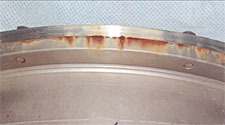
Waste packages containing intermediate-level waste (ILW) are currently being stored prior to emplacement in a deep Geological Disposal Facility (GDF). A multi-disciplinary team led by AMEC is currently carrying out a study for the Nuclear Decommissioning Authority (NDA) Radioactive Waste Management Directorate (RWMD) to improve understanding of the durability of Intermediate Level Waste (ILW) container materials in atmospheric conditions relevant to interim stores and the operational period of a GDF.
Quintessa’s contribution to the project is the development of a model to assess the potential for atmospheric corrosion of stainless steel ILW containers in storage and during the operational phase of a GDF in the UK. The model has been implemented in custom-designed software, Atmospheric Corrosion of Stainless Steel in Stores (ACSIS), which can be used to assess the extent of localized corrosion and stress corrosion cracking and, equally importantly, to inform store designers and operators how to avoid atmospheric corrosion through appropriate control of environmental conditions.
The model accounts for the initiation and propagation of localized corrosion (either pitting or crevice corrosion) and stress corrosion cracking (SCC) of austenitic or duplex stainless steel containers as a result of the deliquescence of surface salt contaminants. The model first characterises the time-dependent nature of the corrosive environment in terms of the duration of, and interval between, wetting events based on temperature and relative humidity data from the store or GDF and knowledge of the nature of the surface contaminant. Various criteria are used to determine whether localized corrosion and/or SCC initiate during a given wetting episode and, if initiation does occur, the extent of damage that may result. The output of the model includes the number of corrosion episodes and the depth of the pit, crevice, and/or crack.
Three phases of model/software development are included in the project, the output of the first two of which were presented at the Corrosion 2013 conference in March 2013. A copy of the paper that accompanies the presentation may be downloaded from here. NDA expects to make the output of the project available at the completion of the third stage, currently planned for 2014